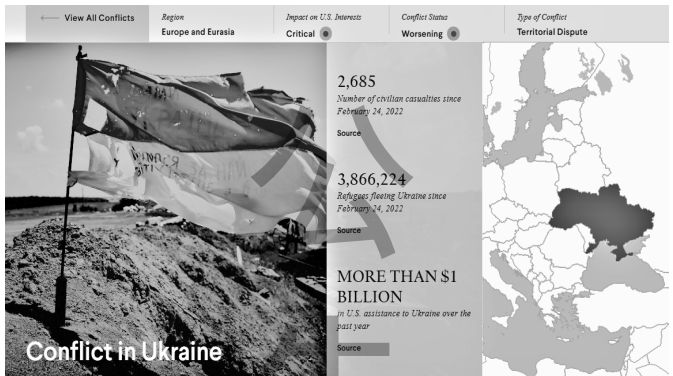Ⅳ. Reading Comprehension Since Russia launched a full-scale military invasion into Ukraine on February 24, 2022, fighting
has caused many civilian deaths and pushed Ukrainians to flee to neighboring countries—the majority of
whom have arrived in Poland, a NATO country where U.S. troops are preparing to offer assistance to
refugees.

In December 2021, Russia’s foreign ministry issued a set of demands calling for the United States
and the North Atlantic Treaty Organization (NATO) to cease any military activity in Eastern Europe and
Central Asia, to commit against further NATO expansion toward Russia, and to prevent Ukraine from
joining NATO in the future. The United States and other NATO allies rejected these demands.
In early February 2022, U.S. President Joe Biden ordered around 3,000 U.S. troops be deployed to
Poland and Romania to counter Russian troops. Negotiations between the United States, Russia, and
European powers—including France and Germany—did not result in a resolution.
In late February 2022, Russian President Vladimir Putin ordered troops to Luhansk and Donetsk,
separatist regions in Eastern Ukraine, claiming the troops served a “peacekeeping” function. On February
24, Putin announced the beginning of a full-scale land, sea, and air invasion of Ukraine. Biden has since
issued severe sanctions, in coordination with European allies, targeting four of Russia’s largest banks, its
oil and gas industry, and U.S. technology exports to the country.
In an emergency United Nations session, 141 of 193 member states voted to condemn Russia’s
invasion of Ukraine and demanded that Russia immediately cease its use of force in Ukraine. The United
States has banned U.S. imports of Russian oil and natural gas. The U.S., following Ukrainian President
Volodymyr Zelenskyy’s address to Congress, announced an additional $800 million in military assistance. Biden also ordered 7,000 U.S. troops to move to Germany. Direct negotiations between Russia and
Ukraine have continued. Meanwhile, Ukrainian military assets, urban residential areas, communication
and transportation infrastructure, and hospitals have sustained shelling and bombing attacks. Civilians
have been facing a humanitarian crisis with acute shortages of food, water, and heat.
Background
Armed conflict in eastern Ukraine erupted in early 2014. The previous year, protests against
Ukrainian President Viktor Yanukovych’s decision to reject a deal for greater economic integration with
the European Union (EU) were met with a violent crackdown. The protests widened, escalating the
conflict.
In March 2014, Russian troops took control of Ukraine’s Crimea region. Vladimir Putin cited the
need to protect the rights of Russian citizens, and then formally annexed the peninsula after Crimeans
voted to join the Russian Federation in a disputed local referendum. Two months later, pro-Russian
separatists in the Donetsk and Luhansk regions of eastern Ukraine held a referendum to declare
independence from Ukraine. Armed conflict in the region quickly broke out between Russian-backed
forces and the Ukrainian military.
 In December 2021, Russia’s foreign ministry issued a set of demands calling for the United States
and the North Atlantic Treaty Organization (NATO) to cease any military activity in Eastern Europe and
Central Asia, to commit against further NATO expansion toward Russia, and to prevent Ukraine from
joining NATO in the future. The United States and other NATO allies rejected these demands.
In December 2021, Russia’s foreign ministry issued a set of demands calling for the United States
and the North Atlantic Treaty Organization (NATO) to cease any military activity in Eastern Europe and
Central Asia, to commit against further NATO expansion toward Russia, and to prevent Ukraine from
joining NATO in the future. The United States and other NATO allies rejected these demands.